Wrapping up 2022
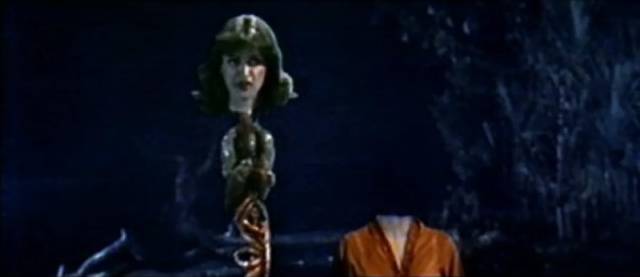
It’s a new year so I ought to be doing something fresh and original here. But between the aggressive onset of winter and recuperating from my recent heart attack, I feel a bit bogged down. Hunkered down in my apartment, I know I should be making productive use of my time, but instead I spend endless hours watching YouTube clips – comedy and political commentary – and, of course, watching movies. So once again, there’s pressure (self-imposed) to clear the docket and mention, if not delve into, what I spent much of December staring at somewhat distractedly.
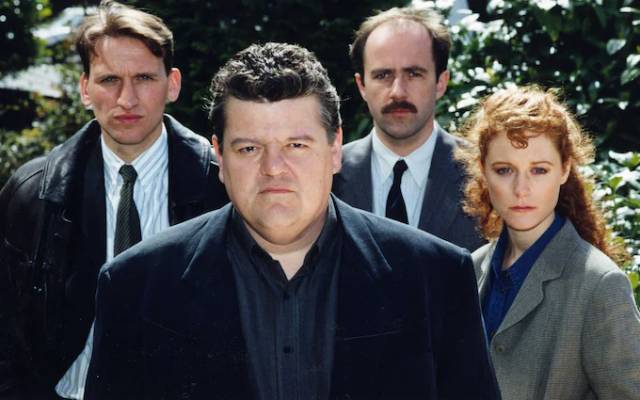
When Robbie Coltrane died back in October, I ordered a DVD set of all eleven Cracker episodes, made between 1993 and 2006, most of which I’d seen a couple of decades ago. The passage of time has definitely affected perception and the image of a deeply flawed man – with serious addiction issues (alcohol, tobacco and gambling) and lousy interpersonal skills – being tolerated (and forgiven) because he’s such a genius doesn’t really fly any more. Coltrane’s Fitz supposedly has amazing insight into the minds of murderers because of his own flaws, but he’s actually a rampaging embodiment of toxic masculinity, inexplicably irresistible to women (his long-suffering wife, his police colleague, celeb-obsessed stalkers). Although the quality of the writing and cast do maintain interest, the show is dramatically implausible, with the cops always sitting back and allowing psychologist Fitz to tear into suspects with a verbal brutality which would never be legally viable (one victim of his technique actually describes what he does as “emotional rape”). Naturally, he’s always right and always gets a confession. The show’s treatment of race, class, rape, misogyny, and homophobia adds a progressive air, but in the end we’re always expected to accept Fitz’s vile, abusive behaviour as a fair price for uncovering the truth of other people’s transgressions. (ITV Studios region 2 DVD, with a one-hour retrospective documentary)
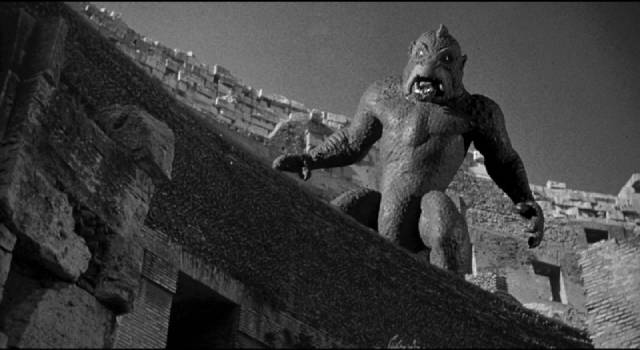
I revisited a couple of early Ray Harryhausen movies on Blu-ray from Indicator. Both It Came From Beneath the Sea (Robert Gordon, 1955) and 20 Million Miles to Earth (Nathan Juran, 1957) are standard ’50s sci-fi B-movies designed to showcase Harryhausen’s stop-motion effects. In the first, Kenneth Tobey and Faith Domergue have to save San Francisco from a giant octopus; in the second William Hopper and Joan Taylor have to save Rome from a pissed off reptile from Venus. Both follow the same basic formula – minor conflicts about the best way to deal with the menace, a perfunctory nod to romance – but everything is just there to frame the animated set-pieces which are still impressive even decades after the advent of CGI. Harryhausen is particularly good with giving the Venusian Ymir some personality (not so easy with an octopus!), the scene of it hatching from its gelatinous egg proving to be one of his finest pieces of animation. Each disk comes with a commentary and numerous featurettes, and has both the original black-and-white version and the Legend Films colourised version supervised by Harryhausen – although the concept of colourisation remains problematic, the technology has definitely evolved a long way since the early days and, though I only sampled them, they look quite convincing.
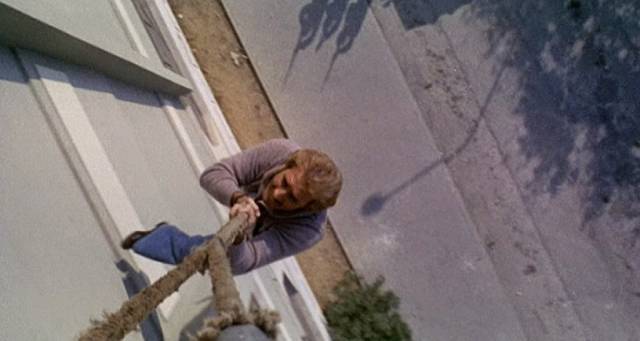
The two latest releases from Cauldron Films see the company getting back to what seemed to be their original mission after a number of odd tangents. Stelvio Massi’s Convoy Busters (1978) is an oddly bifurcated poliziottescho, with the first half devoted to Maurizio Merli’s cop uncovering high-level corruption in Rome only to have his superiors squash his investigation; after accidentally killing another cop, he transfers to a small seaside town where the worst thing seems to be some punks hassling the local school teacher in a bar. But as romance blooms between Merli and the teacher, he uncovers a gun-running operation controlled by a local big-shot. I kept waiting for the two halves to come together with some link between the gun-runners and the jewel smugglers in Rome, but they remain entirely separate, though Merli gets to relieve his pent-up frustration by slaughtering the gang at the end. (Commentary and multiple featurettes)
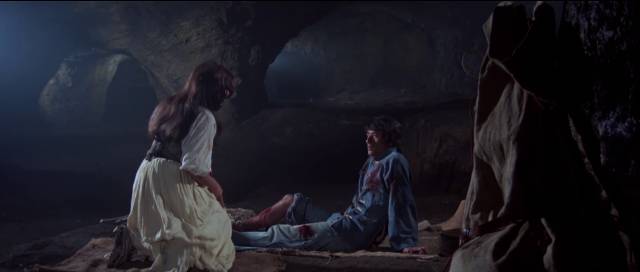
Shanghai Joe (1973) is an odd hybrid. Director Mario Caiano was a typical genre-hopping figure, competent if not terribly creative, moving from sword-and-sandal to Gothic to spaghetti western, giallo and poliziotteschi. Here he introduces Asian martial arts to the spaghetti western, his outsider hero Joe a Chinese immigrant who arrives in the States wanting to be a cowboy only to run into endemic racism. When he finally gets hired in Texas he discovers the “cattle” are impoverished Mexicans being smuggled into the country to be sold as slaves – with an army patrol approaching, his fellow cowboys massacre the Mexicans to keep from being exposed and Joe embarks on a crusade to bring down the wealthy man behind the human trafficking, using his unshakable honesty and martial arts skills to become a kind of proto-superhero. (Commentary, featurettes and a CD of Bruno Nicolai’s Morricone-esque soundtrack)
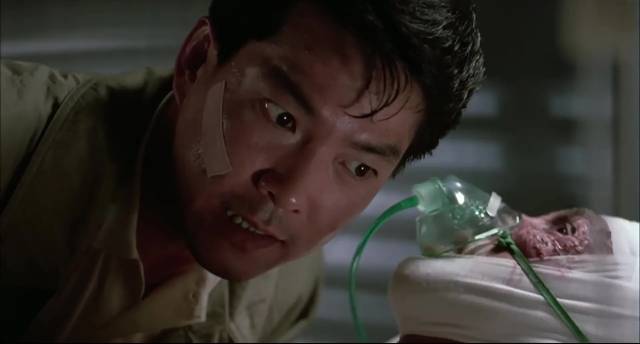
I dipped into my recent 88 Films acquisitions to watch three movies. Alfred Cheung’s On the Run (1988) stars Yuen Biao as a cop whose wife (also a cop) is assassinated. Since the man behind the killing is her commander in the drug force, trying to cover up his own corruption, Biao finds himself framed and – yes – on the run, his only ally turning out to be the cold-blooded hit-woman (Pat Ha) who killed his wife. Fast-paced and gritty, the action scenes aren’t choreographed like dance numbers, but rather are extremely brutal and deliberately inelegant. (Two commentaries, interview featurettes, and a book with an essay and interviews)
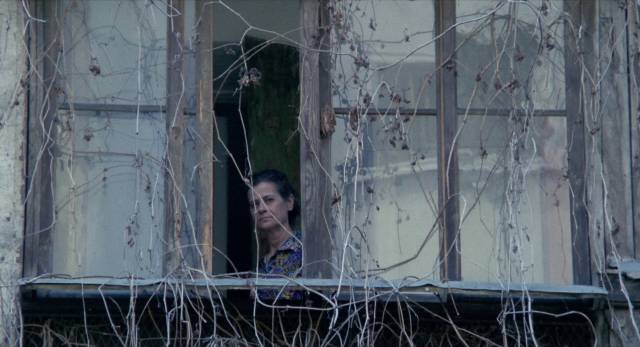
Watch Me When I Kill (1977) is a giallo by Antonio Bido which, as Mikel Koven points out in an accompanying interview, is a solid murder mystery rooted in historical trauma rather than the typical individual psycho-sexual trauma that usually defines the genre. The motive for a series of murders is traced by an amateur investigator back to the final days of World War Two and a family betrayed by their neighbours to the fascists. Bido plays fair with the clues as he teases out the lingering generational effects of a troubled, unresolved history. (In addition to the Koven interview, the disk includes two recent rather arty short films by Bido, essentially classical music videos)
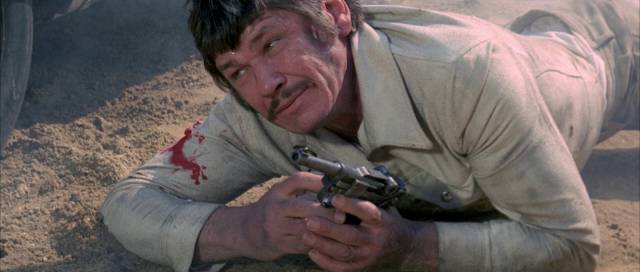
The title of Sergio Sollima’s Violent City (1970) suggests a poliziottescho, but it turns out to be more of a modern film noir about a professional hit-man (Charles Bronson) who falls for the wrong woman (Bronson’s wife Jill Ireland), who uses and destroys a number of men on her way to seizing power in a criminal organization which is transforming into a “legitimate” corporation. The movie starts with a ten-minute car chase which leaves Bronson almost dead; recovered, he spends some time in prison before getting out and returning to the States and searching for the woman and the man who shot him. There’s another lengthy sequence without dialogue as he kills the man, who’s driving in a race. He unexpectedly discovers that the woman is now married to a powerful crime boss (Telly Savalas) who is pressuring Bronson to “join the family”. There are more betrayals and murders before a bloody, fatalistic climax. (Commentary, featurettes and a second disk with an unrestored copy of the shorter U.S. cut The Family)
*
Mondo Macabro is a label which, like Severin, Vinegar Syndrome and some others, specializes in less reputable releases, though they perhaps cast a wider net and troll deeper waters in their search for obscure titles in more remote parts of the cinematic world. Over the past couple of decades, they’ve released genre movies from Pakistan, India, Turkey, and Indonesia among other less familiar corners of pop culture exploitation. Their library of releases can be found on the usual Internet retail sites and, along with my final order from Vinegar Syndrome for 2022, I bought almost a dozen of them, a few of which I had seen over the years, but most of them were unknown to me and I added them to the order on a whim.
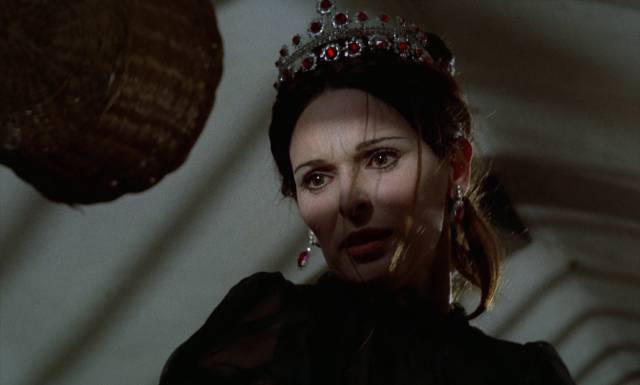
There were two movies by Jorge Grau in the batch, which I ordered mostly because I’d recently watched his masterpiece, The Living Dead at Manchester Morgue. I had seen Blood Ceremony (1973) before, but barely remembered it. It’s a Gothic story set in the 19th Century about a declining aristocracy resorting to brutal methods to preserve a position of privilege. A Countess (Lucia Bosé), fearing encroaching age and the sexual disinterest of her husband, is urged by her servant to emulate her ancestor Erzebeth Bathory and restore her youth by bathing in the blood of virgins. The superstitious population follows folk traditions as they try to stamp out vampirism, while the real threat is the arrogant egotism of their rulers. (Two versions – original Spanish, uncut international – archival interviews with Grau, two commentaries)
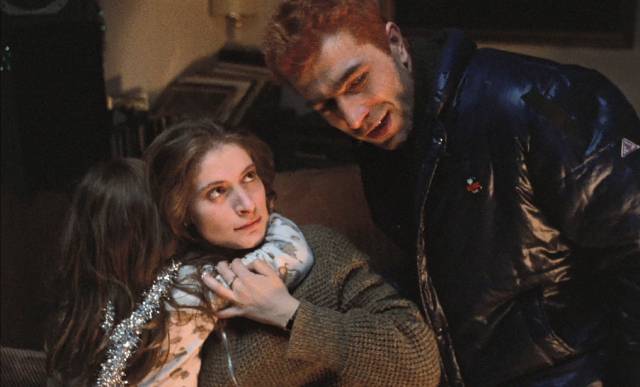
Hunting Ground (1983) is a contemporary story which builds slowly towards a shocking final act which is pretty hard to watch. There are some similarities to Sam Peckinpah’s Straw Dogs (1971) in structure and theme. A liberal attorney (Assumpta Serna) argues in court that her clients are as much victims as those they victimize, their crimes a result of social inequality and economic despair. She tries to cling to these principles even after a home invasion leaves her husband dead. When the younger brother of the gang leader is locked up and commits suicide, he and his buddies set out to get revenge, once again breaking into the attorney’s home. The violence quickly escalates, with the woman being raped and her children brutalized, and she’s finally faced with a reality which is impervious to her political good intentions – with the veneer of civilization stripped away, she abandons empathy and fights back with a brutality equal to that of her attackers. Cast in the form of a serious dramatic treatment of social concerns (reminiscent of some of Eloy de la Iglesia’s movies), the explosion of climactic violence is all the more shocking. (Fifty-minute interview with Grau)
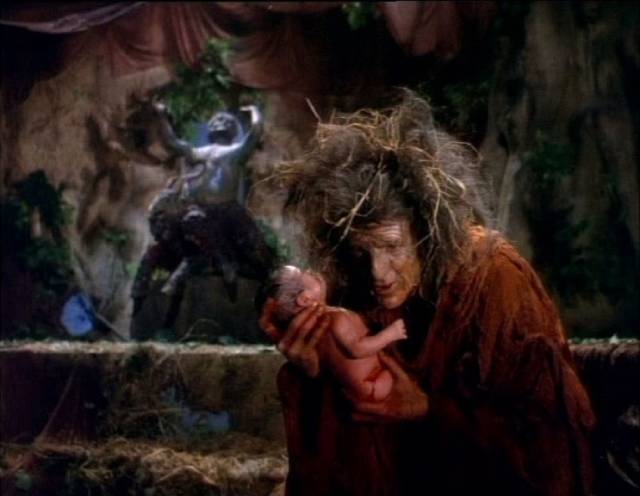
Next, a pair of Mexican horror movies from 1975. I’d seen Juan López Moctezuma’s Alucarda before, but Gilberto Martinez Solares’ Satanico Pandemonium was new to me. Both belong to the explosion of nunsploitation which followed the release of Ken Russell’s The Devils (1971), but unlike Russell’s potent treatment of religion intertwined with politics, they embrace the supernatural and unleash demonic forces via the Church’s repression of female sexuality. Alucarda (Tina Romero) seems to have inherited evil tendencies from her mother, tendencies which surface with the arrival of newly orphaned Justine (Susana Kamini); a budding lesbian relationship triggers open rebellion from the two girls who begin chanting praises to Satan during religious instruction. The priest attempts an exorcism, much to the horror of the local rational doctor (Claudio Brook); all hell breaks loose when Justine dies under torture and Alucarda lets rips with the power to cause people to burst into flames. Even the doctor has to acknowledge that the evil is real. (DVD with a documentary about the director and an interview with Guillermo del Toro about the impact the film had on him)
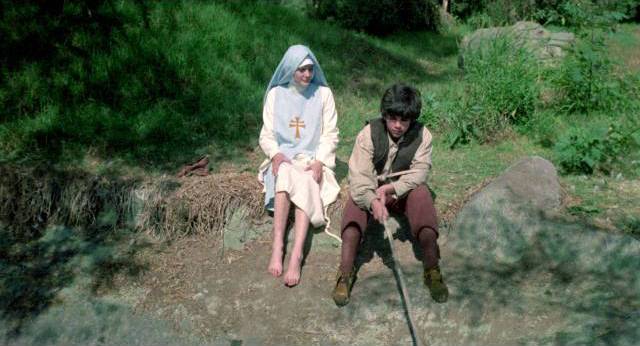
In Satanico Pandemonium, Sister Maria (Cecelia Pezel) is targeted by the devil, who stokes her repressed sexual desire and channels her resentment that she was passed over for Mother Superior. She tries to regain control with self-flagellation, but once awakened her desire is overwhelming. She seduces nuns and peasants, commits murder, and is finally offered what she wants by the devil – when she hesitates, he gives her a vision of a future in which she’s tortured and killed by the Inquisition. Accepting the devil’s offer, she returns to the convent to preside of a decadent orgy which climaxes with the other nuns murdering her – at which point it turns out the whole thing has been a feverish dream as Sister Maria lies in her cell dying of the plague. Much clumsier than López Moctezuma’s film, it nonetheless has some striking imagery. (Interview with the director and a featurette on nunsploitation)
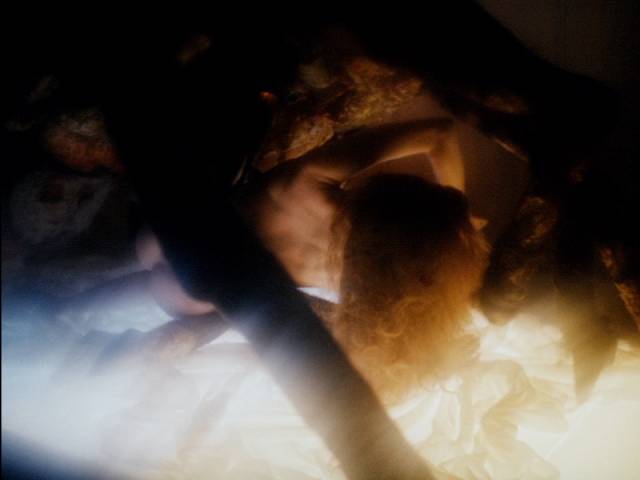
Another pair of disks deal with a girl’s sexual awakening in perverse and disturbing ways. Vasili Mass’ Spider (1991) was shot in Latvia in the aftermath of the collapse of communism and seems like a kind of imaginative explosion after decades of repression. Vita (Aurelija Anuzhite), a student, is spotted by artist Albert (Liubomiras Laucevicius) who has been commissioned to create a painting of the Annunciation for a church; he insists that she must be his model for the Virgin Mary. Hardly a pious man, Albert’s studio is full of feverish works reminiscent of Bosch and the atmosphere – and his obvious erotic attraction to Vita – unbalances her. She has disturbing dreams, including being sexually attacked by Albert in the form of a giant spider, and descends into a kind of libidinous madness within which she discovers her own sexual power, growing in strength and maturity. The imagery is often quite striking and at times the film reminded me of Jaromil Jires’ Valerie and Her Week of Wonders (1970), though it never quite attains that film’s elegant and fully articulated vision of sexual awakening. (Interview with the director, plus some behind-the-scenes footage)
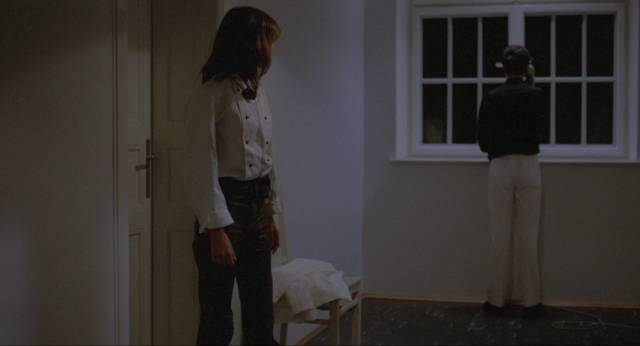
Eckhardt Schmidt’s Der Fan (The Fan, 1982) is darker and more disturbing. Simone (Désirée Nosbusch) is an alienated teenager obsessed with pop star R (Bodo Staiger), whose blank, inexpressive persona permits her to project her own feelings onto him. She waits daily for the mailman to bring her a reply to her fan letters, but when they don’t materialize she imagines that someone is intercepting them to keep R from knowing that she is his ideal mate. She eventually runs away from home and hitchhikes to Munich, where R notices her among the fans clamouring for autographs outside the television studio where he’s taping a special. Overwhelmed by his attention, she passes out and wakes inside the studio, where he lets her join the audience and then leaves with her after the show. She believes they’ve made the emotional connection she’s dreamed off, while it’s obvious that he just sees her as an eager and available groupie. Having taken her to a remote villa where they have sex, he’s no longer interested … and she takes drastic measures to keep him with her – by killing and eating him. The Fan is a blackly comic dissection of the lopsided relationship between celebrities and their fans, with imagery which links that unhealthy psychology to Fascism and it’s power to colonize the minds of those who desperately need to have their identity validated by someone who possesses cultural power. Nosbusch, just seventeen at the time, gives a remarkable, unsettling performance; Bodo Staiger was the lead of the German New Wave band Rheingold and is convincingly chilly and entitled as R. (Interview with Schmidt)
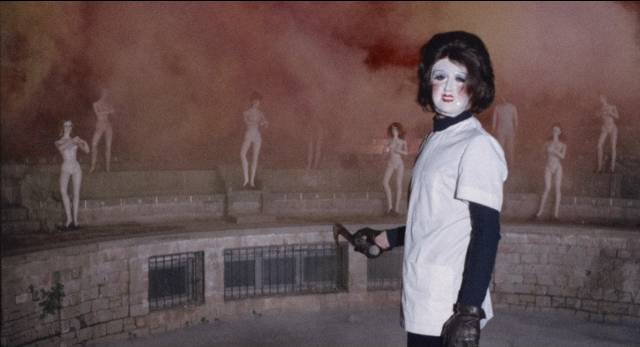
Continuing the unplanned pattern of pairs, another two movies deal with deranged killers whose crimes are rooted in childhood trauma. In Miguel Madrid’s The Killer of Dolls (1975), credited to the pseudonym Michael Skaife, Paul (David Rocha) is the son of a gardener who tends the grounds of Condessa Olivia (Helga Liné). A little odd, Paul has a fixation on dolls and mannequins, frequently seeing them as people and people as them. When his parents go on vacation, leaving him in charge of the gardens, he quickly loses whatever tenuous hold he’s had on reality. The Condessa tries to seduce him and is deeply offended when he obviously finds her daughter Audrey (Inma de Santis) more attractive. Given to dressing as a woman and wearing a wig and doll mask, Paul spies on couples making out in the park and begins murdering women who seem to be mannequins – this confusion reaches its climax when he becomes confused between Audrey and a mannequin which resembles her. His madness is finally explained when we learn that his sister died as a child and his mother dealt with her grief by transforming him into a substitute daughter; he grew up with the sister as a resentful and violent second personality which has finally grown strong enough to take control of him. (Two commentaries and a pair of interviews)
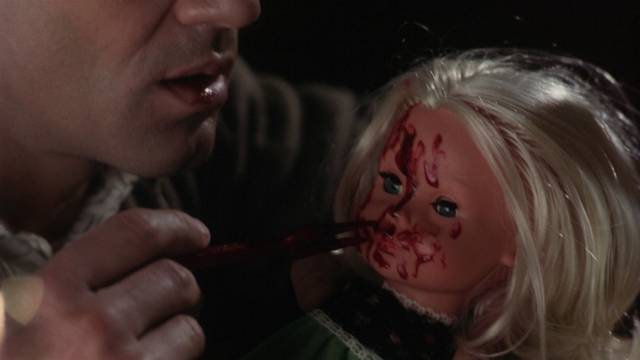
Bloodlust (1977), a Swiss production directed by Croatian Marijan Vajda at the end of a twenty-five year career, stars Werner Pochath as a deaf-mute who works as a clerk in an office where his social awkwardness makes his coworkers both uncomfortable and mocking. In flashbacks, it’s revealed that he was severely abused as a child by a drunken father. Quietly infatuated with a girl who lives next door (Birgit Zamulo), he can barely relate to other people (when he visits a prostitute, she kicks him out because he just wants to cuddle, like a child being comforted by his mother); so he breaks into a mortuary and molests a dead woman. This quickly becomes unsatisfying and he begins to mutilate corpses, taking souvenirs (including plucked eyeballs). That too isn’t enough and he uses a forked glass pipette to puncture the bodies and suck out their blood. The papers and police are eager to catch “the vampire”, but seem strangely incompetent, even after he kills a watchman who catches him in the act at the mortuary. After the neighbour girl dies, he digs up her body and molests it in the cemetery, but this too is unsatisfactory … so he follows a couple into the woods and spies on them making love in their car before killing them both, clumsily leaving an identity card which leads the police straight to him. With little narrative tension – it becomes increasingly implausible that the authorities can’t catch the man in the act – the film rests entirely on Pochath’s creepy performance, which is effective but not quite enough to sustain the running time. (Interviews with the director and actress Zamulo)
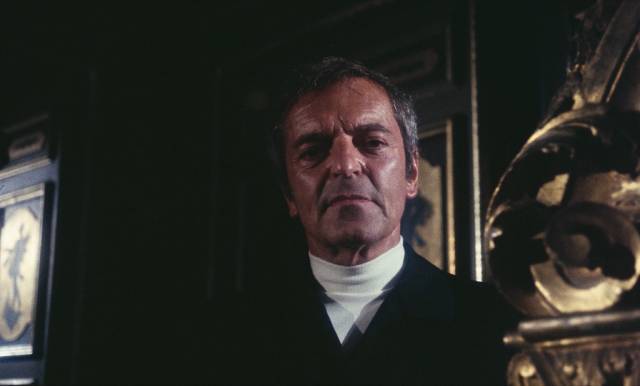
I might lump Michel Lemoine’s Seven Women for Satan (1974) in with the previous pair, though where they both aim to frame their more exploitable elements in works with obvious artistic intentions Lemoine takes the sleazier low road. Once again, we have an unhinged man who gradually loses his ability to distinguish between his sadistic fantasies and reality, leading from dreams in which he hunts women and achieves a sexual climax with their death to actually killing a number of women. His actions are manipulated by his servant Karl (Howard Vernon, who unsurprisingly is the movie’s highlight), who is determined to unleash the Count’s hereditary identity as the descendant of Count Zaroff, the villain of The Most Dangerous Game (1932). Other than reviving a family tradition, there’s no clear motive for Karl to drive the Count (played by writer-director Lemoine himself) to homicidal madness. (Brief interview with Lemoine, much longer interview with assistant director Robert de Laroche; two versions – original theatrical and extended, which incorporates a number of deleted scenes – with deleted scenes also presented as an extra, with alternate takes and various editing trims)
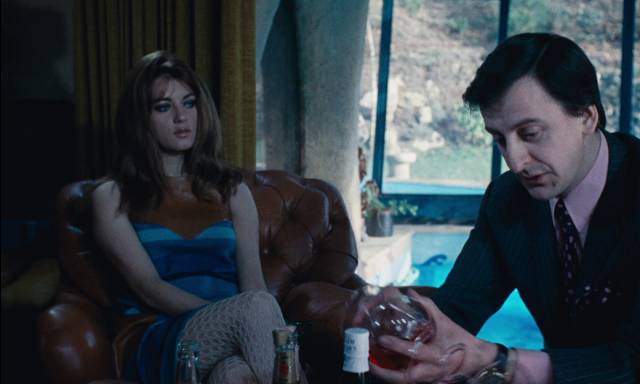
Two movies by French exploitation filmmaker Jean Louis Van Belle come on a double feature disk. The Lady Kills (1971) seems to be a variation on Francois Truffaut’s The Bride Wore Black (1968), with a woman travelling around Europe and bumping off a series of men. But here, rather than avenging her dead husband, she’s targeting the men who raped her mother. Apparently the prologue in which we see the child witnessing this assault was tacked on by the producers who thought the audience might find the movie as made by Van Belle too “subtle” – the woman’s motive was only to be revealed towards the end (the prologue is repeated as a flashback late in the movie). As she pursues her prey, she allows herself to be subjected to misogynistic exploitation, adding a personal justification to her quest for justice for what happened to her mother.
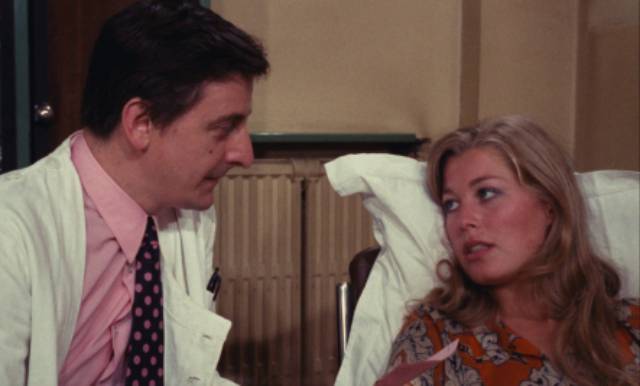
Also on the disk is Pervertissima (1972) and mix of mondo and horror, which follows a woman hired by a magazine to explore the underground of kinky sex in Paris – orgies, S&M, a lesbian bath house, prostitution, sleazy nightclubs, with some sequences actual documentary, including an interesting encounter with real-life avant garde poet Andre Vernier – but then she gets herself committed to a clinic run by a Dr. Vilard, whose sex therapy turns out to involve extreme forms of mind control in service of a plan for world domination. The abrupt introduction of a mad scientist plot transforms the movie into something you might expect from Jess Franco (a pity Van Belle didn’t hire Howard Vernon for the role), though Van Belle lacks Franco’s obsessive quality … or Jean Rollin’s poetic quality for that matter. (The disk includes introductions to both movies by writer Christophe Bier and a half-hour piece with various critics and Van Belle himself discussing his work)
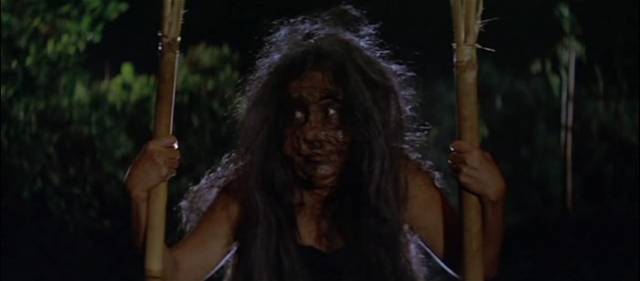
Finally, one of the most truly weird titles unearthed by the company, H. Tjut Djalil’s Mystics in Bali (1981). This virtually unclassifiable movie seems to hail from a parallel cinematic universe, rooted in a folk culture very different from those we might already be familiar with. Crude, with rudimentary but imaginative effects, I think I first connected with this a couple of decades ago because it unexpectedly visualized something I’d read about many years earlier when I was into reading books about the occult; in a survey of vampires around the world, I was struck by an account of Indonesian bloodsuckers which were distinctly different from the European variety – in Indonesia, they took the form of a head which detaches from the body, dragging its entrails below as it flies about in search of victims. And here in Djalil’s movie, we get exactly that, only even more disturbing as the head attacks a pregnant woman and sucks the fetus from her womb. That is definitely something you won’t see anywhere else.
But there’s more. American student Cathy (Ilona Agathe Bastien) has arrived in Bali to do research for her book about witchcraft around the world, hoping to learn about a particularly malevolent practice called Leák. Her boyfriend/guide Mahendra (Yos Santo) unwisely agrees to take her out into the woods to find a powerful witch, in fact a Leák Queen (Sofia W.D.). With long straggling hair concealing her deformed face and long curving fingernails, she approaches accompanied by thunder and lightning, cackling demonically. After a few questions, she agrees to take Cathy as a student and over several nights introduces her to the magic – which among other things involves them both transforming in various animals, most disturbingly giant pigs which retain certain human characteristics.
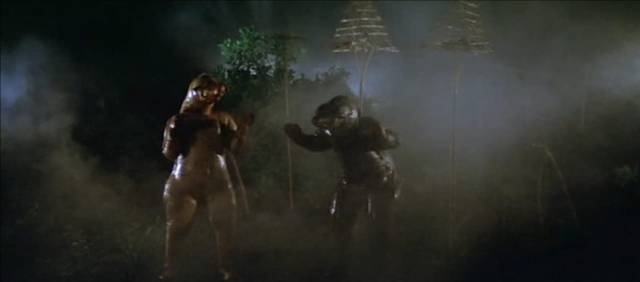
Once the witch’s hold over Cathy is complete, she announces that she needs blood in order to gain full power and attain immortality, and to accomplish this she detaches Cathy’s head and sends it floating off with her intestines trailing beneath it. Although the effects are not very sophisticated, they work surprisingly well; there’s a combination of a puppet head for wide shots as it floats around the village and into a pregnant woman’s bedroom and blue-screen for closer shots in which the exposed guts appear to be a paper cut-out. And yet, because the image is so startling and unusual, the technical crudity doesn’t undermine the impact.
Concerned about the changes in Cathy, Mahendra consults his Buddhist uncle and the wise man finds her body while she’s off gathering blood and sticks some wooden spikes into the exposed neck so that her head can’t reattach – at which point, she struggles to pull the spikes out with her teeth. In the finale, Mahendra and his uncle face off in a magical duel with the powerful witch and the possessed Cathy, firing bolts of energy at each other until things are settled with the sunrise.
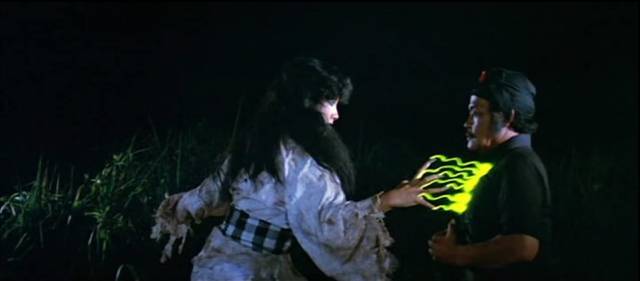
While the acting is perfunctory and the English dubbing (the only option) is pretty bad, Mystics of Bali casts a strange spell which isn’t quite like any other movie I’ve seen. Djalil went on to make some other oddities (particularly Lady Terminator [1989] and Dangerous Seductress [1992]), which contain some equally off-the-wall elements, but Mystics remains in a class of its own. It’s a pity the DVD only has a few text extras – a knowledgeable commentary would have been greatly appreciated.
Comments